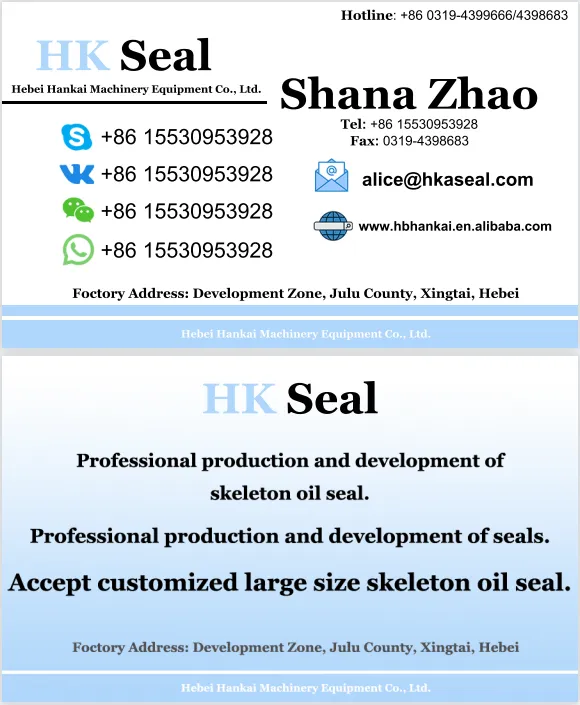11 月 . 04, 2024 15:27 Back to list
Hydraulic Cylinder Seal Maintenance and Repair Techniques for Optimal Performance
Understanding Hydraulic Cylinder Repair and Seals
Hydraulic systems are foundational to various industrial applications, from construction equipment to manufacturing machinery. Among the critical components of a hydraulic system is the hydraulic cylinder, which converts hydraulic energy into linear motion. Over time, these cylinders may experience wear and tear due to continuous use, leading to leaks and reduced efficiency. One of the primary reasons for failure in hydraulic cylinders is the degradation of seals. Understanding the repair process and the role of seals is essential for maintaining the integrity and performance of hydraulic systems.
The Role of Seals in Hydraulic Cylinders
Seals are vital components in hydraulic cylinders. They ensure that the hydraulic fluid remains contained, preventing leaks while allowing the cylinder to function effectively. There are various types of seals used in hydraulic systems, including
1. Rod Seals These seals prevent fluid from leaking out of the cylinder when the piston rod is extended or retracted. They must withstand dynamic pressure and are usually made of durable materials to resist wear.
2. Piston Seals These seals are located between the piston and the cylinder wall. They ensure that hydraulic fluid remains in the chamber behind the piston, providing the necessary force for operation. Piston seals are designed to handle high pressure and are crucial for maintaining cylinder efficiency.
3. End Seals These seals are found at the ends of the cylinder, serving as barriers to prevent external contaminants from entering the hydraulic fluid. They are essential for extending the lifespan of hydraulic systems by keeping dirt and other particles out of the cylinder.
4. Backup Rings Often used in conjunction with primary seals, backup rings provide additional support and prevent the seals from extruding under high pressure.
Common Issues with Hydraulic Seals
Over time, seals can become damaged due to several factors, including
- Wear and Tear Continuous operation leads to physical degradation of the seals, causing them to lose flexibility and effectiveness.
- Contamination Dirt, dust, and other contaminants can scratch seals or disrupt their functioning, leading to leaks.
- Temperature Fluctuations Extreme temperatures can cause seals to harden or become too soft, affecting their ability to create a reliable barrier.
- Chemical Exposure Certain hydraulic fluids or other chemicals can degrade seal materials, further increasing the likelihood of leaks.
hydraulic cylinder repair seals

Repairing Hydraulic Cylinders
When a hydraulic cylinder starts to leak, prompt repair is crucial to prevent further damage and maintain operational efficiency. Here’s a general overview of the repair process
1. Diagnosis The first step involves identifying the source of the leak. This can be done through visual inspection or pressure testing. Understanding whether the issue lies with the rod seal, piston seal, or other components is essential for effective repair.
2. Disassembly Once the problem is diagnosed, the hydraulic cylinder must be disassembled. This involves removing the cylinder from the machinery and carefully taking apart its components while ensuring that no further damage occurs.
3. Inspection Each component, especially the seals, must be thoroughly inspected for wear, damage, or contamination. This step helps to identify any additional issues that may need to be addressed during the repair.
4. Seal Replacement Old or damaged seals must be replaced with new, high-quality seals appropriate for the application. Quality seals are crucial for ensuring the longevity of the repair.
5. Reassembly After replacing the seals and any other damaged components, the cylinder is reassembled with care to ensure everything is properly aligned and secure.
6. Testing Once reassembled, the hydraulic cylinder should be tested under operational conditions to ensure that the repairs were successful and that there are no leaks.
Preventive Measures
To extend the life of hydraulic seals and reduce the need for repairs, regular maintenance is vital. This includes
- Routine Inspections Regularly checking for signs of wear or leaks can help catch problems early.
- Fluid Quality Control Ensuring that the hydraulic fluid is clean and free of contaminants can prevent premature seal degradation.
- Environmentally Controlled Usage When possible, using hydraulic equipment in controlled environments can minimize exposure to detrimental conditions.
In summary, understanding hydraulic cylinder repair and the critical role of seals can significantly enhance the reliability and efficiency of hydraulic systems. With proper maintenance and timely repairs, operators can ensure their hydraulic systems remain functional and effective for years to come.
-
The Power of Advanced Sealing: High-Pressure Solutions for Modern Machinery
NewsOct.29,2024
-
Optimizing Machinery with High-Performance Oil Seals
NewsOct.29,2024
-
Maximizing Machinery Efficiency with Advanced Oil Seals
NewsOct.29,2024
-
Ensuring Equipment Longevity with Quality Oil Seals
NewsOct.29,2024
-
Enhance Equipment Performance with Quality Oil Seals
NewsOct.29,2024
-
Custom Oil Seals for Specialized Machinery Needs
NewsOct.29,2024
-
The Role of Wiper Seals in Dust Sealing and Oil Protection
NewsOct.20,2024
Products categories
















